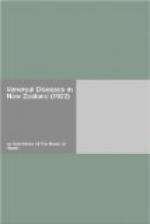(D.) Incidence among Maoris.
It is even more difficult than in the case of the European population to say what is the prevalence of venereal diseases amongst Maoris. The Director of the Division of Maori Hygiene (Dr. Te Rangi Hiroa) in a statement to the Committee says:—
“Venereal disease made great ravages amongst the Maori population in the early days of colonization. To this may be attributed much of the sterility, with histories of repeated miscarriages, that existed in the transitional period of Maori history. Most of the old men—hemiplegias, and paraplegias, and subsequent general paralysis of the insane—gave an old history of syphilis. These cases that I saw twenty years ago have now disappeared.
“In my experience of eighteen years’ constant work amongst the Maoris venereal disease has been comparatively rare. It disappeared amongst the people, only to recrudesce in some localities as fresh infection was introduced by the white man, or brought back to the settlements by visits to the white towns. I see very little of it at present, but now and again hear reports from medical officers that it has cropped up in the settlements near them ... In all these cases I am convinced that the origin is from a white source, and the problem amongst the Maoris is not nearly so serious as amongst Europeans. It seems to me unjust that the idea should be circulated that the Maoris are a source of danger to the European community—the reverse is much more likely.
“It is impossible for me to supply accurate data as to the incidence of the disease amongst the Maori race at present, but I am confident that reports have a natural tendency to become exaggerated. I do not consider that returned Maori soldiers, owing to the treatment they received before being discharged from the service, have been a factor in the introduction of the disease amongst the settlements. If they have in some areas, it has been from fresh infection, which their experience of prostitution in Egypt and Europe has made them more liable to acquire from professional and amateur prostitutes in towns. At the same time, the experience of returned soldiers as to the value of treatment makes them more likely to seek such aid.”
(E.) Death-certificates.
There are no trustworthy statistics in any part of the British Empire of the deaths due to venereal disease. Many persons die from illnesses which result from an initial syphilis contracted perhaps many years prior to death. It is well known that medical practitioners, from a laudable desire to spare the feelings of relatives, refrain from stating the primary cause of death in such cases, and merely enter the secondary or proximate cause. For the same reason, the statistics regarding deaths due to alcoholism, and perhaps in a less degree some other factors in the mortality returns, are incomplete and consequently useless.
Both the Royal Commission on Venereal Diseases and the Birth-rate Commission recommended that the medical attendant should issue two certificates—one, which would be a simple certificate of death, to be handed to the relatives, and the other, a confidential certificate giving the primary cause of death, which would be transmitted to the Registrar.




